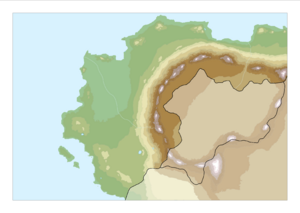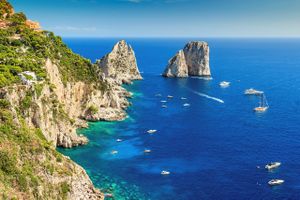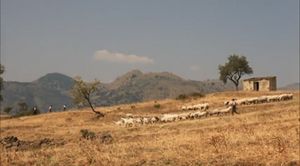Difference between revisions of "Salisford"
m (Text replacement - "₡" to "₵") |
m (Reworded a couple paragraphs and fixed a few typos) |
||
| Line 57: | Line 57: | ||
'''Salisford''', officially the '''Kingdom of Salisford''' ([[Salisfordian]]: '''Salforto''') is a Medium sized nation on the Southern landmass of [[Terraconserva]]. It is bordered to the south by [[Creeperopolis]] and [[El Salvador]], to the east by [[El Salvador]] and [[Arcadia]], and to the north and west by ocean. Salisford's capital city is [[Savotta]]. | '''Salisford''', officially the '''Kingdom of Salisford''' ([[Salisfordian]]: '''Salforto''') is a Medium sized nation on the Southern landmass of [[Terraconserva]]. It is bordered to the south by [[Creeperopolis]] and [[El Salvador]], to the east by [[El Salvador]] and [[Arcadia]], and to the north and west by ocean. Salisford's capital city is [[Savotta]]. | ||
| − | Due to its geographical position, Salisford has been historically | + | Due to its geographical position, Salisford has been historically influenced by both the Creeperians to the south and the Ayeroshubics to the north. Salisfordian lands were originally home to nomadic tribes in the central plain as well as small hunter-gatherer societies in the highlands. During the height of the Romanyan Empire, the Romanyans would conqueer and colonize most of what is now Salisford and assimilated the local plains tribes. These assimilated tribesmen would eventually become the Savottans, who would dominate post-Romanyan Salisford. |
| − | The Romanyan province of Savotta (in what is now northern Salisford) would survive the fall of the Romanyan Empire. The governor of the province, called the Dux, would rule the province autocratically. Over time the bureaucratic elements of the province would give way for traditional feudal relationships. In 302 AD, the Savottan Dux would be converted to Catholicism by Saint Tiberius the Missionary, and with him most of Savotta converted as well. In the following decades, the Savottans would conquer most of the lands which are now part of Salisford. In 546 AD, Dux Tiberias Valencius would declare himself King of Salisford, which marked the end | + | The Romanyan province of Savotta (in what is now northern Salisford) would survive the fall of the Romanyan Empire. The governor of the province, called the Dux, would rule the province autocratically though the remnants of the Romanyan bureaucratic system left behind. Over time the bureaucratic elements of the province would give way for traditional feudal relationships. In 302 AD, the Savottan Dux would be converted to Catholicism by Saint Tiberius the Missionary, and with him most of Savotta converted as well. In the following decades, the Savottans would conquer most of the lands which are now part of Salisford. In 546 AD, Dux Tiberias Valencius would declare himself King of Salisford, which marked the end of the old bureaucratic Romanyan system and the beginning of the feudal Old Salisfordian Kingdom. |
Over time, the Ayeroshubic language would evolve into a vulgar form of Ayeroshubic and then the language would split into Savottan and Proto-Arcadian. Savottan then would evolve into what we now call Salisfordian. | Over time, the Ayeroshubic language would evolve into a vulgar form of Ayeroshubic and then the language would split into Savottan and Proto-Arcadian. Savottan then would evolve into what we now call Salisfordian. | ||
Revision as of 18:59, 9 December 2020
Kingdom of Salisford Salforto | |
|---|---|
Motto: "Per Dio, Re, e Famiglia"
" Jackian: "For God, Family, and King" | |
 | |
| Capital and largest city | Savotta |
| Official languages | Salisfordian |
| Ethnic groups |
|
| Religion | Salforti Catholic (official and dominant) |
| Demonym(s) | Salisfordian |
| Government | Devolved Hereditary Monarchy
|
• Monarch | Francesco II |
| Carlo Valenza | |
| History | |
| 546 AD | |
| 1782 AD | |
| 1790 AD | |
| 1794 AD | |
| 1800 AD | |
| Population | |
• 2019 estimate | 74.2 million |
| GDP (nominal) | 2019 estimate |
• Total | ₵3.571 Trillion QSC (12th) |
• Per capita | ₵48,138 QSC (7th) |
| Gini (2019) | medium |
| HDI (2019) | very high |
| Currency | Salisfordian Lira (₤) (SFL) |
| Time zone | AMT-5, -6 |
| Driving side | right |
| Calling code | +8 |
| Internet TLD | .sf |
Salisford, officially the Kingdom of Salisford (Salisfordian: Salforto) is a Medium sized nation on the Southern landmass of Terraconserva. It is bordered to the south by Creeperopolis and El Salvador, to the east by El Salvador and Arcadia, and to the north and west by ocean. Salisford's capital city is Savotta.
Due to its geographical position, Salisford has been historically influenced by both the Creeperians to the south and the Ayeroshubics to the north. Salisfordian lands were originally home to nomadic tribes in the central plain as well as small hunter-gatherer societies in the highlands. During the height of the Romanyan Empire, the Romanyans would conqueer and colonize most of what is now Salisford and assimilated the local plains tribes. These assimilated tribesmen would eventually become the Savottans, who would dominate post-Romanyan Salisford.
The Romanyan province of Savotta (in what is now northern Salisford) would survive the fall of the Romanyan Empire. The governor of the province, called the Dux, would rule the province autocratically though the remnants of the Romanyan bureaucratic system left behind. Over time the bureaucratic elements of the province would give way for traditional feudal relationships. In 302 AD, the Savottan Dux would be converted to Catholicism by Saint Tiberius the Missionary, and with him most of Savotta converted as well. In the following decades, the Savottans would conquer most of the lands which are now part of Salisford. In 546 AD, Dux Tiberias Valencius would declare himself King of Salisford, which marked the end of the old bureaucratic Romanyan system and the beginning of the feudal Old Salisfordian Kingdom.
Over time, the Ayeroshubic language would evolve into a vulgar form of Ayeroshubic and then the language would split into Savottan and Proto-Arcadian. Savottan then would evolve into what we now call Salisfordian.
The Old Kingdom would survive and thrive by relying heavily on the feudal system and the traditional relationships between the ruler, the aristocracy, the church, and the people which were built up over time. However, in the late 17th and early to mid 18th centuries, the Salisfordian monarchs would begin to centralize and absolutize their rule over the realm. This would culminate with King Vittorio the cruel, who would rule as an absolute monarch with complete control over almost every aspect of Salisfordian life. Vittorio the Cruel, due to his competence, was able to govern effectively. However, the following monarchs would be considerably less competent. Which would end with the reign of Cesario the Bad, who would be manipulated and controlled by a group of wealthy aristocrats.
This situation would end in 1782 with the beginning of the Salisfordian Revolution. A popular revolt in the city of Savotta would force the King to flee from the city and hand control over to the revolutionaries. This would lead to an 8-year civil war between the Republicans, who were supported by the bourgeoisie, the urban aristocracy, and the urban poor, and the Royalists, who were supported by the rural aristocracy, rural peasants and farmers, and the highland Salisfordians. Because of foreign support, the Republicans would ultimately gain the upper hand and force the King into exile. The Republicans would draft a consitution and form the Republic of Salisford.
The Republic faced many difficulties. At the beginning of its existence, a Republican hero of the war, Spartaco Annese, would seize control of the government and start a reign of terror. During this reign of terror, Annese would order the execution of clerics, former royalists, his own political rivals, and anybody else who would get in his way. The terror would end in 1792, when Annese would be seized by a mob of peasants and beaten to death. For the following two years, the Republic would only effectively rule urban areas, as the rural parts of Salisford were deeply royalist and the roads of Salisford were menaced by Royalist bandits who would rob or attack any person traveling who did not vow their loyalty to the royalist cause.
In 1794, following a famine caused by political deadlock and inefficiency in the higher levels of the Republic, a Counter-Revolution would begin. Led by a rural aristocrat who was able to evade capture by the Republic for the entirety of the reign of terror, Orazio di Brolo. This would begin a 6-year civil war, which would ultimately end in the royalists' favor. Following the royalist victory, King Cesario's son, King Carlo the Good, would return to Salisford and was crowned King in Savotta. This would mark the beginning of the New Kingdom.
King Carlo the Good was considerably more competent than his father, and following advice given from him by his closest allies and the Primate of Salisford, he would decentralize the Kingdom considerably and reaffirm the traditional relationships which were annulled by the Republic. King Carlo would seize the massive estates which where owned by the republican leaders. Following the seizure, King Carlo broke up the estates and provided land to any family in good-standing who applied for land and promised to use the land for producive means.
In the following years and decades, the Kingdom would prosper and would slowly become one of the richest countries on the continent. Salisford would go on to be a founding member of the Terraconserva Council of Nations and CODECO.
Contents
History
Ancient Salisford
Pre-Salisfordian Civilization
(WORK IN PROGRESS)
Romanyan Period
Christianization
(WORK IN PROGRESS)
The Old Kingdom
(WORK IN PROGRESS)
Salisfordian Revolution
(WORK IN PROGRESS)
Salisfordian Republic
(WORK IN PROGRESS)
Salisfordian Counter-Revolution
(WORK IN PROGRESS)
Re-establishment of the Salisfordian Monarchy
(WORK IN PROGRESS)
Modern Era
(WORK IN PROGRESS)
Government
Overview
Salisford is a monarchy, headed by a autocratic monarch who rules through decree. Despite the monarch's absolute authority, he has little power. Relying on a bureaucracy of local lords, administrators, and vassal relationships to effect his decrees. The monarchy itself is dedicated to the idea of subsidiarity, with most problems being dealt with on the local level, only moving to higher powers when local powers are unable to deal with the problem effectively.
The Monarch
The Monarch acts as head of state and head of government for Salisford. Sovereignty is vested in the King, both legitimate in blood and by deeds. The King rules the domain, and those who reside within are his subjects. However, the power of the King is restricted by the doctrine of the Church, the traditional laws and usages of the realm, and through a series of pronvincial councils and state-independent intermediate bodies.
The Royal Council
The Royal Council is Salisford's equivalent of a cabinet. Staffed by Great Officers of the Realm as well as advisors the King personally invites onto the Council. The Council assists and advises the King on policy, law, and every facet of maintaining the Realm. Decrees and statues from the King are first discussed with the Council and, if the King is satisfied with their advice, these decisions become ordinance. These decrees are called decrees from the King-in-Council.
Concessiones
The Concessiones are ancient and traditional rights granted to areas, peoples, and institutions by a Salisfordian monarch. These Concessiones are usually an acknowledgement of local or regional self-rule (such as in the Church, or in remote areas). The development of the Concessiones coincides with the Catholic doctrine of Subsidiarity. Uniquely, recent monarchs have granted Concessiones to Catholic trade and labor unions, as well as to other Catholic worker organizations.
The Church
The Church plays a major role in Salisfordian political, social, and religious life. As the King claims a divine right to rule, his rule is confirmed by a bishop in the semi-sacramental rite of coronation. The Salisfordian monarchy believes Catholicism to be the cornerstone of Salisford itself, and is politically active in its defense.
Geography
Salisford is divided into a number of provinces which are governed by a royally-apointed governor. The coast of Salisford is rocky with high cliffs, however, parts of the coast are lower in elevation and have sandy picture-esque beaches. The interior of Salisford is flat and temperate. The majority of Salisford's population lives in the central plain, however, there are large population centers on the Western Highlands.
Climate of Salisford
(WORK IN PROGRESS)
Economy
The Salisfordian economy is industrialized and strong economic bases in the fields of manufacturing, engineering, and tourism. However, a large part of the Salisfordian economy is also based in agriculture. Notable Salisfordian corporations include the Royal Salisfordian Arsenal, Beretta, and Piaggio Aerospace.
Salisford's agricultural base is centered around smaller family farms, which have been distributed by royal decree from large estates previously owned by the landed aristocracy.
Salisford is a major exporter of grains, fruits, and vegetables. Most notably: wheat, barley, olives, tomatoes, and garlic.
Military

The Salisfordian military is made up of a core base of volunteers, who make up specialist detachments, the officer corps, and a small standing force. This volunteer force is supplemented by conscripts. Salisfordian males are conscripted into government service after graduation from secondary school. This can be in a civilian service corps for a period of 4 years, or in military service for a period of 2 years.
Salisfordian Air Force
Due to the highly technical nature of the Salisfordian Air Force, the majority of the branch is formed of volunteer career soldiers, and conscripts are only taken in for non-technical jobs, such as Security Forces, Administratives Officers, etc.
Salisfordian Pilot Training is restricted to volunteers.[1]
Demographics
Salisford is made up of a majority of Salisfordians. Due to strict citizenship laws, there is a limited amount of non-Salisfordians who are Salisfordian citizens. However, there is a somewhat-sizable number of non-citizen residents who work and live in Salisford.
See Also
Other Nations
- Creeperopolis
- El Salvador
- Eminople
- Greater Sacramento
- Groffenord
- Lyoa
- Malgax
- Morova
- New Gandor
- Paleocacher
- Quebecshire
- Rakeo
- Reia
- Second State of the Church
- Sequoyah
- Terranihil
- Willdavie
- Xusma
References
- ↑ Abdilla, Giuseppe (March 14, 2014). Stato Dell'Aviazione. Royal Salisfordian Air Force Standards and Evaluation Department.





